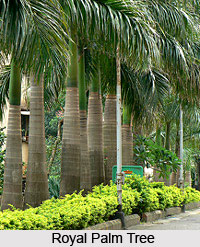 The `Royal Palm Tree` tree has been imported to India in the very recent times. The scientists of the world know this tree as `Oreodoxa Regia`. The name `Oreodoxa` originated from two Greek words that mean "mountain`` and "glory" and the word `Regia` means "regal". It belongs to the family of `Arecaceae`. The other names of this tree in English are `Mountain Glory, and `Bottle Palm`.
The `Royal Palm Tree` tree has been imported to India in the very recent times. The scientists of the world know this tree as `Oreodoxa Regia`. The name `Oreodoxa` originated from two Greek words that mean "mountain`` and "glory" and the word `Regia` means "regal". It belongs to the family of `Arecaceae`. The other names of this tree in English are `Mountain Glory, and `Bottle Palm`.
The tree is really a graceful one and it is extensively cultivated in India. Almost all the parts of the tree can be used in some way. People normally plant the `Royal Palm Tree` in the parks and in their gardens. The tree possess a lot of assets. One of the major assets is that the tree is defiant to the wind and it has salt drench. It can achieve the height of about 20 m in general. The tree can easily decorate the avenues very nicely if you plant them there. The stem of the tree is straight and it does not contain any branches. It distinctively thickens towards the top. However, this is not habitual to the tree and hence cannot be described as a definite characteristic of the tree. You can see this very characteristic in most of the young trees.
The bark of the tree is silky and of palest grey in colour. It is ringed very evenly as well. A polished, green coloured column formed by the leaf sheaths rises from this sharply divided grey bole. After enlarging at its base, from the summit emerges a bunch that is consist of a large number of long and arched leaves. The leaves of the `Royal Palm Tree` are jam-packed with some narrow leaflets that are normally 75 cm in length. These leaflets are inserted alternately in opposite ways. This suggests that they lie in two different planes. They remain almost in one plane towards the tip and this time they have similarity with a coconut leaf. The new leaves also remain like this. A large number of the leaflets are rounded or folded and the whole thing presents a delightfully shaggy appearance. The flower sprays are enclosed in sheaths. They spring from the top of the trunk and below the green column.
The spathes are erect before they open. After opening, they lie horizontal and the sprays that contain many branches burst forth. The male and female flowers stay on the same `Royal Palm Tree`. The male flowers are larger than the female ones and open first. Both the flowers are of straw yellow in colour and they appear during the Summer and the Rainy season. The fruits of this nice tree are small in size and round shaped. They are light purple in colour when they become mature and normally appear in clusters. As this tree has not been grown long enough in India, it does not have the extensive uses. People cook and eat the tender top segment of the tree as a vegetable. The leaf-sheaths are also flattened out and are used as sleeping mats.



















